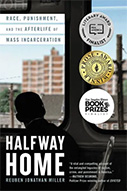Halfway Home: Race, Punishment, and the Afterlife of Mass Incarceration

Author: Reuben Jonathan Miller
Publisher: Little, Brown and Company, 2021. 341 pages.
Reviewer: Sam Bieler | September 2022
Halfway Home: Race, Punishment, and the Afterlife of Mass Incarceration differs sharply from many recent studies of the justice system. Reuben Jonathan Miller’s ethnographic study of life after incarceration accepts some of the formalisms of academic writing, but rejects others, in favor of personal reflection. It indicts the present system of post-release criminal justice, but offers no program for its replacement. It tells the vividly and poignantly written tales of people whose offenses are more minor, but also does not shy away from offering sympathy to those whose crimes are serious. For those who have not encountered the petty indignities that the justice system inflicts on those who fall into its grasp, Halfway Home will be a revelation. But readers who have some experience with this world may be left wanting. The book does not note how to fix the problems it identifies or even argue to simply burn it all down. For some, it will likely be enough to expose the system’s flaws. Readers who want to know how these flaws should be fixed, however, will find themselves hungry for more.
At its core, Halfway Home is an ethnography, a deep dive into a small set of people’ lives after they are released from prison. Miller follows them as they try to navigate the world with a far more limited set of rights than most Americans enjoy. While ethnographers generally spend a good amount of time with their subjects, Miller’s investment is more substantial than moot. He has walked a long way with the people he discusses, and this effort is reflected in the deep and intimate portraits he paints of their lives. Halfway Home shines when he describes the absurdities that these people face as they return home. They are forced into drug abuse programs, despite never having used drugs. They are dragooned into training programs for jobs that, explicitly or implicitly, they will never be able to hold. They are told to obtain stable housing, then shoved into halfway homes from which they can be evicted at a moment’s notice or branded with a conviction that makes it nearly impossible to find an apartment. Even those familiar with the often-Kafkaesque nature of the justice system will find new frustration following these journeys.
The tale is also intensely personal. Some in Miller’s own family have been incarcerated, and these stories find their way onto his pages too. Miller, himself, is an inescapable presence and his challenges navigating the very hurdles the justice system imposed on the families of those released are core to his indictment of America’s post-release system.
He is also unusually courageous in his choice of whose story to tell. Often, critiques of the justice system conspicuously skirt discussing people who have committed serious crimes. There is even a convenient, common shorthand for the “proper” subjects of reform: the “non, non, nons,” or the non-violent, non-serious, non-sexual. The political attractiveness of ignoring those outside this group is clear, yet the resulting picture off the justice system is invariably misleading. People who have committed violent, sexual, or otherwise serious crimes make up well over half of most states’ prison populations. Yet, their stories are rarely discussed. Miller refuses to follow this well-trod path. One of the people whose story he recounts participated in a rape and murder. Others have gotten into brawls, carried weapons, or drained their families’ patience and bank accounts as they cycle in and out of prison. They are not the self-evident, sympathetic cases so commonly brought forward by reformers; yet, Miller tells their story just the same.
This refreshing candor sets Halfway Home apart. By refusing to paint a simplistic picture of those released from prison, Halfway Home encourages the reader to honestly reckon with the challenges of reform and the question of what it means to fully welcome those who have been incarcerated home.
Nor is this the only bold choice that Halfway Home makes. It is also unapologetic about being an ethnographic study. Not all researchers are so brave. As statistical research has become increasingly central to criminology, some ethnographies have responded by burying the actual research in a sea of supporting citations and statistics. Not so with Halfway Home. Miller references the work of others, but he does not subject his readers to an endless review of prior studies. The insights and experiences of those he walks with are not immediately followed up with a statistical reference or a quote from some famous scholar, as if to defensively insist on the legitimacy of his insights. His subjects are the star and he makes no apologies for it. Readers are better off for this courage. Listening to the stories of those released, as they accumulate job training certificates but no actual job, has a potency that cannot be matched by statistical recitations.
There are limits to how far one can take this strategy, and the book nudges up against them. At times, when Miller’s own experiences of working with those incarcerated take center stage, Halfway Home feels more like an autobiography than an ethnography. In those moments, the effects of the otherwise moving stories diminish as Miller’s reaction to the abuses of this system overtake the focus on the system itself. These moments, however, are rare enough that Halfway Home suffers little for it. Overall, it remains a compelling example how an ethnography can explore the dynamics of the criminal justice system with unmatched vividness, so long as the researcher has the courage to commit to the concept.
At the end, however, this vividness, combined with the willingness to explore even the stories of those who have committed serious crime, becomes something of a poison pill. Miller does not lay out a way to deal with the abuses that he describes. He does not target a particular class of laws or set of disabilities for abolition. He is a relentless critic of the system, but he never describes how it should be dismantled or what should replace it. Not every book needs to be a comprehensive roadmap for reform, but most books targeting the justice system at least offer a suggestion for how to move forward, even if it is little more complex than targeting a law or practice for elimination.
Halfway Home does not. Indeed, when it recounts its last tale, it comes to an abrupt end. At this point, the vividness of Miller’s tales, and the courage of relaying the stories of those who committed serious crimes, puts the reader in a bind. The people they have walked 300 pages with have endured, often unnecessarily, numerous hardships. Yet, they have also frequently struggled to reenter society and failed, harming others in the process. Halfway Home does not say what should be done about this. Nor is it self-obviously evident that all disabilities imposed by incarceration should be shed at prison door. For example, firearm ownership is one of the many rights lost once one is convicted of a felony. Should this right be restored upon release? People convicted of sex offenses often labor under a raft of post-release restrictions so onerous that some have taken their own lives rather than endure them. Are these laws ripe for reform? What about those who have been convicted of financial fraud or other white-collar crimes: should they be allowed to work at financial institutions on their release? Should such institution be prevented from learning of those peoples’ crimes before hearing them? The answer to all of these questions may well be “yes.” But if that is the answer that Miller wants to give, it is not apparent from Halfway Home, nor are most readers likely to find that answer to be so self-obviously correct that they would take those conclusions for granted.
Today, the post-release system America has created and imposed real, serious harm on people trying to rebuild their lives. Miller is a relentless and effective critic of these abuses, but less able to guide the reader to what this world should actually look like. He deserves praise for painting a vivid picture of the world as it is, as well as for showing what a committed and unapologetic ethnography can look like. It remains for another book to figure out how to fix these flaws.
Samuel Bieler is a federal law clerk.


